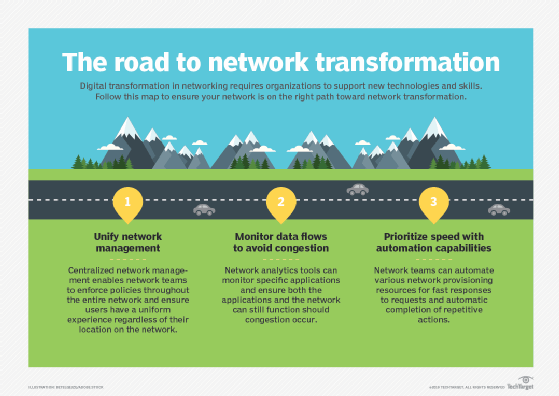
Torbz - Fotolia
What are the steps I should take for network transformation?
The path to digital transformation has three points that all organizations should reach to ensure their network is ready for digital transformation.
Digital transformation, or DX, digitizes various processes so businesses can seek out new opportunities and adapt to rapid change. Because the enterprise network forms the foundation of any technology, it, too, must prepare for change and eventual network transformation.
These three key factors can help ensure your underlying network can adapt to constant changes in DX and network transformation ambitions.
1. Centralize network management to achieve flexibility
Organizations may cast aside legacy networks with well-defined boundaries and hop-by-hop static configurations in the DX era. Instead, today's networks must embrace hybrid and multi-cloud environments, the potential to reach geographically dispersed branch offices, and mobile and remote users that are constantly on the move. Uniform experiences no matter where end users reside is crucial for networks capable of network transformation.
The key to network flexibility is centralized network policy creation. That way, network and security administrators can ensure their teams enforce their policies no matter if a user is on the corporate LAN, in a remote office or accesses applications and data in a public cloud. Two common technologies used to achieve centralized network management are software-defined technologies and multi-cloud management platforms.
2. Optimize application-specific data flows
More than ever before, an array of leased lines and VPN technologies stitch geographically dispersed networks together. While speeds and latency numbers improved over the years, WAN connectivity remains an area where congestion occurs. Also, many DX-centric business applications now rely more on real-time communications to operate effectively. Thus, any slowdown in mission-critical applications can be detrimental to the business's bottom line -- or net income.

This is where advancements in application and network analytics come into play. These tools can identify applications and the health of data flows as data traverses the borderless networks in which organizations now operate. The analytics can then better tune a network so critical and real-time applications do not suffer should congestion occur.
3. Automate network provisioning tasks
One major factor of DX and network transformation is that speed matters. If an organization pivots to a new market trend, they can't wait for network administrators to provision the networking resources they need. Instead, the network must have built-in intelligence to auto-provision network resources based on high-level information that loosely describes the intended need.
This is precisely what technologies called intent-based networks seek to accomplish. This level of automation added into a network provides the speed a DX-focused business needs to achieve network transformation.





